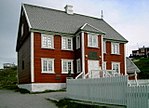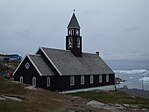Ilulissat
Jakobshavn | |
|---|---|
From upper left: Illumiut neighbourhood, Old town, Ilulissat Icefjord, Knud Rasmussen's Museum, Zion's Church | |
| Coordinates: 69°13′N 51°06′W / 69.217°N 51.100°W | |
| Sovereign state | |
| Autonomous territory | |
| Municipality | Avannaata |
| First mention | 15th century |
| City Status | 16th century |
| Area | |
| • City | 11.25 km2 (4.34 sq mi) |
| • Metro | 47.00 km2 (18.15 sq mi) |
| Highest elevation | 2,010 m (6,590 ft) |
| Lowest elevation | 1 m (3 ft) |
| Population (2020 (city, settlements))[3] | |
| • City | 4,670 |
| • Density | 420/km2 (1,100/sq mi) |
| • Urban | 4,491 (City of Ilulissat) |
| • Metro | 342 (Settlements: Ilimanaq Oqaatsut Qeqertaq and Saqqaq) |
| • Metro density | 103.5/km2 (268/sq mi) |
| • Ethnicity | 90.98% Greenlandic 9.02% Other[2] |
| Time zone | UTC−02:00 (Western Greenland Time) |
| • Summer (DST) | UTC−01:00 (Western Greenland Summer Time) |
| Postal code | 3952 |
| Area code | (+299) 94 |
Ilulissat, formerly Jakobshavn or Jacobshaven,[4] is the municipal seat and largest town of the Avannaata municipality in western Greenland, located approximately 350 km (220 mi) north of the Arctic Circle. With a population of 4,670 as of 2020,[5] it is the third-largest city in Greenland, after Nuuk and Sisimiut. The city is home to almost as many sled-dogs as people.
In direct translation, Ilulissat is the Kalaallisut word for "Icebergs" (Danish: Isbjerge).[6] The nearby Ilulissat Icefjord is a UNESCO World Heritage Site,[7] and has made Ilulissat the most popular tourist destination in Greenland.[8] Tourism is now the town's principal industry. The city neighbours the Ilulissat Icefjord, where there are enormous icebergs from the most productive glacier in the northern hemisphere.
- ^ "Den Store Danske: Areal fordelt efter kommune / region". Naatsorsueqqissaartarfik. Retrieved 23 January 2014.
- ^ Naatsorsueqqissaartarfik: Naatsorsueqqissaartarfik, table BEDST3', period 2014
- ^ "Naatsorsueqqissaartarfik: Ilulissat City/Settlements (Ilulissat Municipality, Qaasuitsup Kommunia), 2014 (table: BEDST3)". Statistics Greenland. Retrieved 14 February 2014.
- ^ i.a., Lieber, Francis & al. Encyclopædia Americana: A Popular Dictionary of Arts, Sciences, Literature, History, Politics and Biography. "Greenland". B.B. Mussey & Co., 1854.
- ^ "Population by Localities". Statistical Greenland. Archived from the original on 26 July 2020. Retrieved 7 April 2020.
- ^ "Ilulissat". Qaasuitsup Municipality. Archived from the original on 2 June 2012. Retrieved 11 July 2010.
- ^ "21 World Heritage Sites you have probably never heard of". The Daily Telegraph.
- ^ "Ilulissat Icefjord". Qaasuitsup Municipality. Archived from the original on 13 February 2013. Retrieved 11 August 2012.









